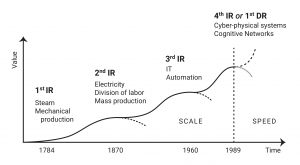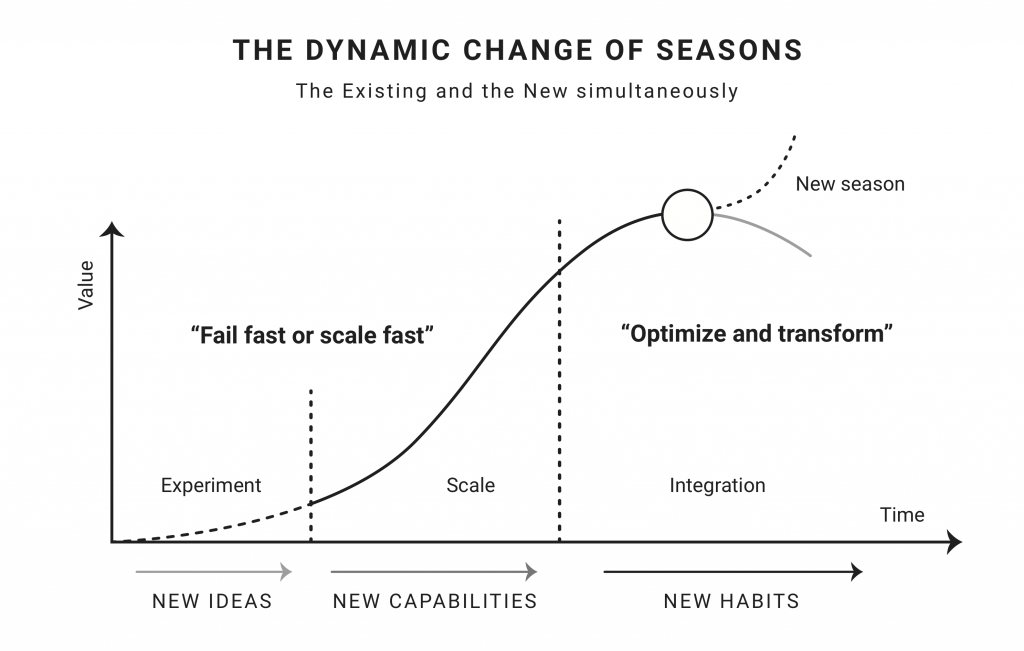By Mikael Trolle (CEO & Co-Founder of IDONEA)
and Tjorven Ludes (Marketing Coordinator of IDONEA)
Our world is undergoing radical, disruptive changes at an accelerating speed. Innovation, digitalization, and technological progress fundamentally transform whole industries, reshape consumer demands, and challenge conventional business logics.
This demands a new approach to leadership and business strategy: One where inspiring leaders replace strict business plans with an ambitious dream, where the focus shift from results towards performance, and where reinvention is embraced. Read on to find out more.
The Trigger: Remarkable Changes and Exponential Speed
Your standard mobile phone nowadays contains a thousand times more computing power than all of NASA’s computers in 1969 – which helped send people to the moon. And it’s more than a million times cheaper. That’s weird to imagine, isn’t it?
It is just one of many examples illustrating how the fourth industrial (or first digital) revolution has radically changed the world we live in.

Computers and the internet, once mainly just used in large organizations, are nowadays indispensable facilitators of everyday life for basically everyone. Autonomous cars, not long ago seen as a future utopia, are now nearly ready for the mass market.
The connectivity between digital technologies, constant collection and connection of data-points alongside the development of innovative technologies is doubling the speed and capacity while reducing the costs of technology. This again, increases the speed of innovation, digitalization, and technology.
Meanwhile, the playing field of organizations has become global. Globalization and global interconnectivity make space and time constraints increasingly irrelevant and easily carry innovation across the world. Innovation, competition, and progress are all global now.
All these factors boil down to a key rationale: The speed of is change exponential.
This, in turn, means that also business leaders have to adjust their thinking (from linear to exponential).
The Consequence: Disruption, Unpredictability, and Opportunity
Leaders need to face the uncomfortable truth: Change and unpredictability will rule business environments. The exponentiality of change makes planning impossible and strips managers of most of the perceived control over outcomes. The cycles of change will shorten, while the volatility of change is likely to increase.
Due to these developments, major changes are taking place right in front of our eyes:
- Consumer Demands: Increasing demand for personalization (instead of standardization), differentiation, authenticity, sustainability & responsibility, maximizing ease of use (and intuitiveness), on-demand access, experience (rather than ownership).
- Business Models: Away from purchase and ownership (or asset) models towards platform and as-a-service models (and again: personalization instead of standardization); The value of data has outpaced the value of physical assets, as it makes services faster and easier distributable, personalized, flexible, cheaper, consumer-focused.
- Basic Assumptions: Taken-for-granted assumptions are becoming increasingly outdated; E.g., optimizing for scale is not the essential competitive advantage it once was – in fact, it can hinder organizations. In fast-changing environments, size can cause slowness and immobility. Speed and innovativeness become factors of superiority.
- Industries: The borders between industries are fading as industries are merging, and some are dying altogether. Innovation and services are growing across industries and sectors.
- Average lifespan of companies: The average lifespan is drastically decreasing as company life cycles are shortening. The turn-over rate at the top of lists regarding the leading or most valuable companies is increasing.
And there is no end in sight for the exponentiality of change. A future driven by AI, IoT, smart technologies and environments as well as unheard-of computing power will fundamentally revolutionize most facets of business, consumption, politics, and social life. Technology will more and more naturally merge with human life.
On the bright side, however, for leaders willing to adjust to these changes, take risks, and reinvent their leadership, these developments bear immense potential. As business success is becoming less dependent on size, organizations of every size enjoy near limitless opportunities to shape the future of business and society.
Yesterday’s dreams and utopias have become the reality of today – and the same will be the case with today’s dreams. Leaders need to dare to follow visions and dreams for the future to turn these challenges into enormous opportunities and become the disruptor instead of the disrupted.
The Need: A New Leadership Model
The question then becomes: How should you lead in times of radical change?
It is becoming clear that traditional performance management isn’t sufficient anymore. Trying to strictly plan, measure, and control outcomes is unsuitable in times of unpredictability and constant change.
The focus has to shift away from planning towards experimenting and developing. It becomes crucial to not only optimize your current offering but to prepare for taking a different direction in the future at the same time. As speed becomes increasingly essential, organizations need to develop increasingly agile, dynamic, and adaptable.
To enable that, organizations need to empower their most valuable resource: Their employees. External rewards (such as bonuses) are, at best, a temporary motivation anymore. True motivation and engagement arise from finding the work you do meaningful.
Consequently, an organization’s inspiring purpose and vision are the key drivers to unlock human potential and performance. The other crucial components of unleashing human potential are a feeling of development, achievement, and performance on an individual and collective level.
To thrive as a leader in a world of change, you cannot make detailed plans, try to control outcomes, or measure success on pre-planned results. Instead, shift your focus back on (understanding) the human factor and increasingly towards digitalization.
To build a disruption-proof business, you need to develop your organization’s resilience, agility, adaptability, and focus on performance and innovation. You will be required to reinvent your business – not just once but cyclically – to spearhead innovation.
Challenge the status quo, the underlying assumptions that have always been taken for granted, and scout for transformation. Be the change you want to see.
The Answer: Leadership of Dreams and Reinvention
So, what is the key to success for leaders?
Detailed plans have to be replaced with an ambitious and inspiring organizational dream. It is on the leaders to ensure that everyone within an organization is equipped with the mindset, framework, and tools to achieve this dream. Moreover, they have to question the status quo, set their sights on the future strategy, and identify those few absolutely crucial details that need to change within the organization to excel in the future.
Leaders have to focus their attention on unfolding the untapped potential of their employees and their organization as a whole. And they need to repeatedly reinvent their business from a position of strength, to stay ahead of competitors and disruptors and spearhead change and innovation.
The Dream: Direction, Ambition, and Inspiration
When leaders develop a dream for the organization to follow, which is clear in its direction while being ambitious and inspiring for the whole organization, employees will see their work as meaningful and full of purpose. As mentioned before, these are the key ingredients to real motivation and engagement.
Simultaneously, it will not limit the organization to specific predetermined results but leaves room to actually reach the optimal results. It may seem contradictory, but by not focusing on results, you will actually be likely to achieve better results.
On top of that, developing an inspiring dream for the whole organization is prone to also resonate with outside stakeholders. When a business anchors the contribution to solving a larger issue within its DNA, it will experience far more interest, sympathy, and willingness to engage by potential customers, partners, and other stakeholders.
The Details: Roles, Skills, and Collaboration
Leaders have to identify the few absolutely crucial details within the organization that need to be changed or developed to succeed in the future. These details are based on the changes and developments within the business environment.
While these details (areas to transform or master) are focused on organizational capabilities, the individual employees occupy an essential part for succeeding with the details.
Leaders need to ensure that employees develop those skills that are vital for reaching the organization’s ambition. These skills should aim towards helping the business develop and master capabilities on an organizational level.
Moreover, leaders should secure, that everyone is put in a role to succeed and foster collaboration between individuals, teams, and departments for more far-reaching, optimized solutions. When those conditions are met, the roles, skills, and collaboration become indispensable elements for succeeding with the details.
The Platform: Mindset and Framework
To make employees more autonomous decision-makers and solution-finders, leaders have to find and communicate a valuable mindset. The mindset translates the dream’s ambition into the details, as a guide for the practical areas of change. It embodies the understanding of how to make the optimal decisions to drive the organization’s transformation.
As the mindset becomes ingrained in the employees’ minds, it will be a point of reference for every decision they make.
At the same time, employees need a framework of rules and norms to work in, marking the boundaries of action.
Once the mindset and framework are in place and fully embraced by the whole organization, employees will be able to move more autonomously, responsibly, and creatively within these confines. This enables more decentralized decision making within an organization and thus far higher speed and innovativeness.
As a result, leaders will unleash the potential of their individual employees, but even more on a collective level, maximizing the organizational potential and performance.
Reinvention and the Dynamic Change of Season
For a business to stay successful over a longer period in times of change, it has to reinvent itself repeatedly and optimally from a position of strength. Otherwise, it may just be a matter of time until even the most optimized offering becomes irrelevant due to changing business logic and customer demands.
To keep a company’s position of strength during the transformation, the current services it provides need to be optimized continuously. The ongoing success of a business enables its fluid transition into a promising future.

Meanwhile, a business needs to start with reinventing itself while still optimizing the current offering. We call that a “dynamic change of seasons”. To succeed, it requires leaders to scout for the changes that will impact the organization in the future, and develop a direction that will keep the company relevant.
Would you like to find out more? Have a look at the Dreams and Details leadership model, read into the book, or feel free to contact us!




